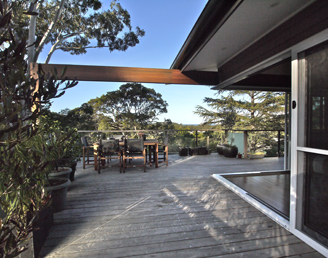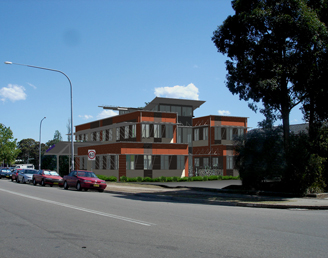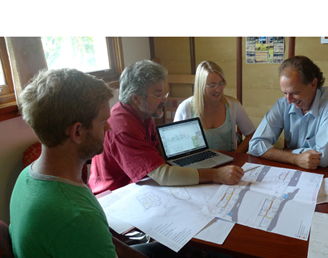Welcome to another bushfire season – demons of our own making
Posted by admin on 15/11/2011 at 4:32 amTHE BIGGEST ESTATE – FIRE MADE IT BUT NOW BURNS IT UP
Or, if you prefer…
BUSHFIRE: A DEMON OF OUR OWN MAKING – APPLYING NEW RESEARCH TO LAND MANAGEMENT AND BUILDING DESIGN
(This post was updated on 20 September 2012 – see link to video at bottom of page.)
Australia used to be one big farm. Before the days of when our wealth grew like sheaves of wheat, before the days of our wealth riding the sheep’s back, the country grew enough to create a varied diet of various vegetables, and a variety of sweet and savoury meats. Large destructive bushfires were unknown. These emerging facts must pique our interest, demand a closer look. It has major implications for the way we design buildings, and manage the whole land. In fact, it challenges all common notions of what is ‘natural’, ‘wilderness’, and ‘landscape’. And, how we plan city edges and design buildings.
Europeans used ploughs to tend the land, but these have never been suited to our soils or climate. Asians used water and terracing to bring forth their crops, but our land never had enough consistent rain to allow this. Here, the plough was made of flame, the terracing made of soil types and natural landform. Here, deliberate decisions were made about what to grow where, and why, all with a careful plan as to when to harvest. Fire was the implement, from Tasmania to the Kimberley. And these were not monocultures such as Europeans planted over thousands of acres, here was multiple cropping, sometimes rotational, with dozens of varieties, with a general focus on pasture.
Who could have made such sophisticated decisions? Well, it appears now that with the exception of Kangaroo Island and the far South-West of Tasmania, the whole of Australia up until 1788 was a managed landscape, a bloody great big farm. There were many ‘owners’, who variously cooperated and squabbled (just like the rest of the world), but all understood the farming method. According to newly published mammoth and all-encompassing research by the ANU’s Prof Bill Gammage, the traditional view of Australia’s vegetation cover is off the mark. The notion that Aboriginal people used to fire to simply flush out wallabies so they could be speared or clubbed, and to make the country easier to pass through, are about as accurate as thinking that buildings design themselves. This is a shocking notion, once sunk in. It means that not only was Terra Nulius wrong in law (aka Mabo, Wik, and the vibe of the thing), but also patently wrong to the eye of the observer, had they only known what they were looking at.
In economic terms, when a company is taken over, the buyer wants to see the books – to see the assets and liabilities, to understand what the sales and turnover are. In short, to get a complete picture of the business’s position. In its takeover of Australia, the British never undertook such an audit of their take-over target, they never understood how the business operated. Based on assumptions and ignorance, they started running the farm they way they had run farms in England. And that’s precisely where it all started to go wrong. There was never any real wilderness in Australia any time in the last 30,000 years at least, all the landscape was made, managed, effectively farmed, then as white settlers like my farming forebears spread across the continent, the land fell into disrepair. Drought hurt more than before, fire damaged where it had not before, water ran off quickly and floods wreaked havoc as never before. Landcare, Peter Andrews and others, have been trying to put Humpty Dumpty together again ever since.
What we see now, as we travel from the suburbs, through the peri-urban fringes, and beyond through national parks to the farmlands beyond (and beyond that to the desert if we make time!), is a land that is dramatically changed since 1788. Then, the most common description of the unsettled country was that “it resembled a gentleman’s park” back in England. This comment, and variations upon those exact words, are recorded thousands of times in contemporaneous documents. The “impenetrable scrub” of Banjo Patterson and Henry Lawson came much later. How can that be? Hundreds of these descriptions are referenced in Gammage’s book, each by trusted observers: explorers, surveyors, even Governor Macquarie. Paintings and drawings, painstakingly detailed in their representations of country – for these were the photographers of the times – show large tracts cleared or semi-cleared, in definite patterns, according to the various purposes of food gathering. No tractors, no ploughs, just flame. Suffice to say that fire was used little and often – here not there, now not then – as a way of encouraging some food types, discouraging others, and maintaining a generally safe livable environment on a continent with significant climate variability. Had they allowed mega-fires to occur, large scale population extinctions would have occurred with it, and there is no record in either archeological or in the dreaming stories.
The hot potato of this knowledge for us in the wider building industry, is that ‘bushfire’ is a demon of our own making. Megafires such as 2009’s Black Saturday, and others like it back through the 20th century, were unheard of prior to the mid 1800s, when the well-treed grasslands had been either cleared totally, or allowed to regrow with dense “under wood” (archaic term). Yet now, we are expected to provide safe shelter in these changed landscapes, now severely fire-prone. This is a double whammy”, with climate change bringing increased extremes and variability with a general increase in baseline temperature, and changed bush management that encourages wild fires.
What concerns me is that the hot potato will become a big grey elephant which just sits in the lounge room, because the change in how we manage the wider landscape has escaped the attention of governments at all levels (to date). I have little confidence that any of them will react to this new and more complete intelligence with any kind of speed or alacrity.
For building designers, design and construction to the bushfire code AS3959-2009 is no guarantee of survival, and may lead to a false sense of security. It adds cost to construction perhaps for no better outcome, and encourages acceptance of the status quo of the likelihood of fires, assuming a sense of resignation, powerlessness. That cannot be allowed to continue, and we must challenge that lazy defeatist attitude.
Governments are representative of the people, and peak industry bodies such as BDA, AIA, and PIA have a responsibility to lead government from places of technical ignorance into the light of better technical understanding. We are the custodians of technical knowledge, governments acquire it from us. But we first must develop that technical knowledge, and Gammage’s research is a huge leap forward in that area. Now we must build on that, and get serious about how we manage this country, before we allow it to just burn up. Apathy and resignation to the status quo is as fatal as any bushfire.
[The Biggest Estate on Earth by Bill Gammage, published by Allen & Unwin, 2011.]
Sustainable House Design
We will help you create a family home that works well, feels good, is kind to the environment, culturally appropriate and reduces your energy and running costs.
Read MoreSustainable Commercial Buildings
We design your building to help reduce your operating costs, optimize the life cycle of your building, increase your property value and increase employee productivity.
Read MoreWorking with Envirotecture
We design beautiful, sustainable buildings that work for you, your family or your business. Full range of building design, consulting and training services.
Read More






















